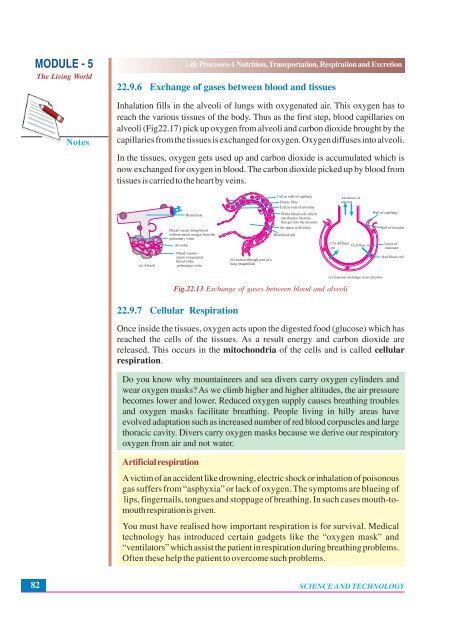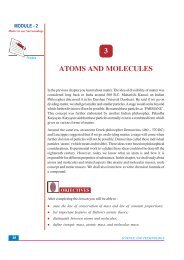Nutrition, Transportation, Respiration and Excretion
Nutrition, Transportation, Respiration and Excretion
Nutrition, Transportation, Respiration and Excretion
You also want an ePaper? Increase the reach of your titles
YUMPU automatically turns print PDFs into web optimized ePapers that Google loves.
MODULE - 5<br />
The Living World<br />
Notes<br />
Life Processes-1 <strong>Nutrition</strong>, <strong>Transportation</strong>, <strong>Respiration</strong> <strong>and</strong> <strong>Excretion</strong><br />
22.9.6 Exchange of gases between blood <strong>and</strong> tissues<br />
Inhalation fills in the alveoli of lungs with oxygenated air. This oxygen has to<br />
reach the various tissues of the body. Thus as the first step, blood capillaries on<br />
alveoli (Fig22.17) pick up oxygen from alveoli <strong>and</strong> carbon dioxide brought by the<br />
capillaries from the tissues is exchanged for oxygen. Oxygen diffuses into alveoli.<br />
In the tissues, oxygen gets used up <strong>and</strong> carbon dioxide is accumulated which is<br />
now exchanged for oxygen in blood. The carbon dioxide picked up by blood from<br />
tissues is carried to the heart by veins.<br />
Fig.22.13 Exchange of gases between blood <strong>and</strong> alveoli<br />
22.9.7 Cellular <strong>Respiration</strong><br />
Once inside the tissues, oxygen acts upon the digested food (glucose) which has<br />
reached the cells of the tissues. As a result energy <strong>and</strong> carbon dioxide are<br />
released. This occurs in the mitochondria of the cells <strong>and</strong> is called cellular<br />
respiration.<br />
Do you know why mountaineers <strong>and</strong> sea divers carry oxygen cylinders <strong>and</strong><br />
wear oxygen masks? As we climb higher <strong>and</strong> higher altitudes, the air pressure<br />
becomes lower <strong>and</strong> lower. Reduced oxygen supply causes breathing troubles<br />
<strong>and</strong> oxygen masks facilitate breathing. People living in hilly areas have<br />
evolved adaptation such as increased number of red blood corpuscles <strong>and</strong> large<br />
thoracic cavity. Divers carry oxygen masks because we derive our respiratory<br />
oxygen from air <strong>and</strong> not water.<br />
Artificial respiration<br />
A victim of an accident like drowning, electric shock or inhalation of poisonous<br />
gas suffers from “asphyxia” or lack of oxygen. The symptoms are blueing of<br />
lips, fingernails, tongues <strong>and</strong> stoppage of breathing. In such cases mouth-tomouth<br />
respiration is given.<br />
You must have realised how important respiration is for survival. Medical<br />
technology has introduced certain gadgets like the “oxygen mask” <strong>and</strong><br />
“ventilators” which assist the patient in respiration during breathing problems.<br />
Often these help the patient to overcome such problems.<br />
82<br />
SCIENCE AND TECHNOLOGY
















